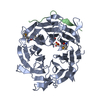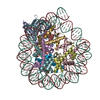+ データを開く
データを開く
- 基本情報
基本情報
| 登録情報 | データベース: PDB / ID: 8siy | |||||||||
|---|---|---|---|---|---|---|---|---|---|---|
| タイトル | Origin Recognition Complex Associated (ORCA) protein bound to H4K20me3-nucleosome | |||||||||
 要素 要素 |
| |||||||||
 キーワード キーワード |  REPLICATION (DNA複製) / REPLICATION (DNA複製) /  chromatin binding (クロマチン) / ORC binding / chromatin binding (クロマチン) / ORC binding /  nucleosome (ヌクレオソーム) nucleosome (ヌクレオソーム) | |||||||||
| 機能・相同性 |  機能・相同性情報 機能・相同性情報Activation of ATR in response to replication stress / Assembly of the ORC complex at the origin of replication / CDC6 association with the ORC:origin complex / Activation of the pre-replicative complex / Orc1 removal from chromatin /  複製起点認識複合体 / establishment of protein localization to chromatin / nuclear origin of replication recognition complex / inner kinetochore / methyl-CpG binding ...Activation of ATR in response to replication stress / Assembly of the ORC complex at the origin of replication / CDC6 association with the ORC:origin complex / Activation of the pre-replicative complex / Orc1 removal from chromatin / 複製起点認識複合体 / establishment of protein localization to chromatin / nuclear origin of replication recognition complex / inner kinetochore / methyl-CpG binding ...Activation of ATR in response to replication stress / Assembly of the ORC complex at the origin of replication / CDC6 association with the ORC:origin complex / Activation of the pre-replicative complex / Orc1 removal from chromatin /  複製起点認識複合体 / establishment of protein localization to chromatin / nuclear origin of replication recognition complex / inner kinetochore / methyl-CpG binding / 複製起点認識複合体 / establishment of protein localization to chromatin / nuclear origin of replication recognition complex / inner kinetochore / methyl-CpG binding /  DNA replication origin binding / DNA replication initiation / DNA replication origin binding / DNA replication initiation /  ヘテロクロマチン / pericentric heterochromatin / methylated histone binding / ヘテロクロマチン / pericentric heterochromatin / methylated histone binding /  動原体 / structural constituent of chromatin / 動原体 / structural constituent of chromatin /  ヌクレオソーム / ヌクレオソーム /  nucleosome assembly / chromatin organization / nucleosome assembly / chromatin organization /  DNA複製 / DNA複製 /  chromosome, telomeric region / protein heterodimerization activity / chromosome, telomeric region / protein heterodimerization activity /  中心体 / 中心体 /  chromatin binding / chromatin binding /  クロマチン / クロマチン /  核小体 / 核小体 /  DNA binding / DNA binding /  核質 / 核質 /  細胞核 / 細胞核 /  細胞質 細胞質類似検索 - 分子機能 | |||||||||
| 生物種 |   Rattus norvegicus (ドブネズミ) Rattus norvegicus (ドブネズミ) Xenopus laevis (アフリカツメガエル) Xenopus laevis (アフリカツメガエル)synthetic construct (人工物) | |||||||||
| 手法 |  電子顕微鏡法 / 電子顕微鏡法 /  単粒子再構成法 / 単粒子再構成法 /  クライオ電子顕微鏡法 / 解像度: 2.9 Å クライオ電子顕微鏡法 / 解像度: 2.9 Å | |||||||||
 データ登録者 データ登録者 | Bleichert, F. / Ekundayo, B.E. | |||||||||
| 資金援助 |  米国, European Union, 2件 米国, European Union, 2件
| |||||||||
 引用 引用 |  ジャーナル: EMBO J / 年: 2023 ジャーナル: EMBO J / 年: 2023タイトル: A dual role for the chromatin reader ORCA/LRWD1 in targeting the origin recognition complex to chromatin. 著者: Sumon Sahu / Babatunde E Ekundayo / Ashish Kumar / Franziska Bleichert /  要旨: Eukaryotic cells use chromatin marks to regulate the initiation of DNA replication. The origin recognition complex (ORC)-associated protein ORCA plays a critical role in heterochromatin replication ...Eukaryotic cells use chromatin marks to regulate the initiation of DNA replication. The origin recognition complex (ORC)-associated protein ORCA plays a critical role in heterochromatin replication in mammalian cells by recruiting the initiator ORC, but the underlying mechanisms remain unclear. Here, we report crystal and cryo-electron microscopy structures of ORCA in complex with ORC's Orc2 subunit and nucleosomes, establishing that ORCA orchestrates ternary complex assembly by simultaneously recognizing a highly conserved peptide sequence in Orc2, nucleosomal DNA, and repressive histone trimethylation marks through an aromatic cage. Unexpectedly, binding of ORCA to nucleosomes prevents chromatin array compaction in a manner that relies on H4K20 trimethylation, a histone modification critical for heterochromatin replication. We further show that ORCA is necessary and sufficient to specifically recruit ORC into chromatin condensates marked by H4K20 trimethylation, providing a paradigm for studying replication initiation in specific chromatin contexts. Collectively, our findings support a model in which ORCA not only serves as a platform for ORC recruitment to nucleosomes bearing specific histone marks but also helps establish a local chromatin environment conducive to subsequent MCM2-7 loading. | |||||||||
| 履歴 |
|
- 構造の表示
構造の表示
| 構造ビューア | 分子:  Molmil Molmil Jmol/JSmol Jmol/JSmol |
|---|
- ダウンロードとリンク
ダウンロードとリンク
- ダウンロード
ダウンロード
| PDBx/mmCIF形式 |  8siy.cif.gz 8siy.cif.gz | 398.4 KB | 表示 |  PDBx/mmCIF形式 PDBx/mmCIF形式 |
|---|---|---|---|---|
| PDB形式 |  pdb8siy.ent.gz pdb8siy.ent.gz | 298.5 KB | 表示 |  PDB形式 PDB形式 |
| PDBx/mmJSON形式 |  8siy.json.gz 8siy.json.gz | ツリー表示 |  PDBx/mmJSON形式 PDBx/mmJSON形式 | |
| その他 |  その他のダウンロード その他のダウンロード |
-検証レポート
| アーカイブディレクトリ |  https://data.pdbj.org/pub/pdb/validation_reports/si/8siy https://data.pdbj.org/pub/pdb/validation_reports/si/8siy ftp://data.pdbj.org/pub/pdb/validation_reports/si/8siy ftp://data.pdbj.org/pub/pdb/validation_reports/si/8siy | HTTPS FTP |
|---|
-関連構造データ
| 関連構造データ |  40522MC  8siuC C: 同じ文献を引用 ( M: このデータのモデリングに利用したマップデータ |
|---|---|
| 類似構造データ | 類似検索 - 機能・相同性  F&H 検索 F&H 検索 |
- リンク
リンク
- 集合体
集合体
| 登録構造単位 | 
|
|---|---|
| 1 |
|
- 要素
要素
-タンパク質 , 6種, 10分子 ACGDHEIFJB
| #1: タンパク質 | 分子量: 71651.547 Da / 分子数: 1 / 由来タイプ: 組換発現 / 由来: (組換発現)   Rattus norvegicus (ドブネズミ) / 遺伝子: Lrwd1 / 発現宿主: Rattus norvegicus (ドブネズミ) / 遺伝子: Lrwd1 / 発現宿主:   Trichoplusia ni (イラクサキンウワバ) / 参照: UniProt: A0A140UHX1 Trichoplusia ni (イラクサキンウワバ) / 参照: UniProt: A0A140UHX1 | ||||||||
|---|---|---|---|---|---|---|---|---|---|
| #2: タンパク質 | 分子量: 15303.930 Da / 分子数: 2 / 由来タイプ: 組換発現 由来: (組換発現)  Xenopus laevis (アフリカツメガエル) Xenopus laevis (アフリカツメガエル)発現宿主:   Escherichia coli (大腸菌) / 参照: UniProt: P84233 Escherichia coli (大腸菌) / 参照: UniProt: P84233#3: タンパク質 |  ヒストンH4 ヒストンH4分子量: 11323.350 Da / 分子数: 2 / 由来タイプ: 組換発現 由来: (組換発現)  Xenopus laevis (アフリカツメガエル) Xenopus laevis (アフリカツメガエル)遺伝子: LOC121398084 / 発現宿主:   Escherichia coli (大腸菌) / 参照: UniProt: A0A8J1LTD2 Escherichia coli (大腸菌) / 参照: UniProt: A0A8J1LTD2#4: タンパク質 |  ヒストンH2A / Histone H2A type 1 ヒストンH2A / Histone H2A type 1分子量: 13962.241 Da / 分子数: 2 / 由来タイプ: 組換発現 由来: (組換発現)  Xenopus laevis (アフリカツメガエル) Xenopus laevis (アフリカツメガエル)発現宿主:   Escherichia coli (大腸菌) / 参照: UniProt: P06897 Escherichia coli (大腸菌) / 参照: UniProt: P06897#5: タンパク質 |  ヒストンH2B / H2B1.1 ヒストンH2B / H2B1.1分子量: 13524.752 Da / 分子数: 2 / 由来タイプ: 組換発現 由来: (組換発現)  Xenopus laevis (アフリカツメガエル) Xenopus laevis (アフリカツメガエル)発現宿主:   Escherichia coli (大腸菌) / 参照: UniProt: P02281 Escherichia coli (大腸菌) / 参照: UniProt: P02281#8: タンパク質 | |  複製起点認識複合体 複製起点認識複合体分子量: 11570.101 Da / 分子数: 1 / 由来タイプ: 組換発現 / 由来: (組換発現)   Rattus norvegicus (ドブネズミ) / 遺伝子: Orc2, Orc2l / 発現宿主: Rattus norvegicus (ドブネズミ) / 遺伝子: Orc2, Orc2l / 発現宿主:   Trichoplusia ni (イラクサキンウワバ) / 参照: UniProt: Q75PQ8 Trichoplusia ni (イラクサキンウワバ) / 参照: UniProt: Q75PQ8 |
-DNA鎖 , 2種, 2分子 KL
| #6: DNA鎖 | 分子量: 46998.945 Da / 分子数: 1 / 由来タイプ: 組換発現 / 由来: (組換発現) synthetic construct (人工物) / 発現宿主:   Escherichia coli (大腸菌) Escherichia coli (大腸菌) |
|---|---|
| #7: DNA鎖 | 分子量: 47457.234 Da / 分子数: 1 / 由来タイプ: 組換発現 / 由来: (組換発現) synthetic construct (人工物) / 発現宿主:   Escherichia coli (大腸菌) Escherichia coli (大腸菌) |
-詳細
| 研究の焦点であるリガンドがあるか | Y |
|---|
-実験情報
-実験
| 実験 | 手法:  電子顕微鏡法 電子顕微鏡法 |
|---|---|
| EM実験 | 試料の集合状態: PARTICLE / 3次元再構成法:  単粒子再構成法 単粒子再構成法 |
- 試料調製
試料調製
| 構成要素 |
| ||||||||||||||||||||||||
|---|---|---|---|---|---|---|---|---|---|---|---|---|---|---|---|---|---|---|---|---|---|---|---|---|---|
| 分子量 | 実験値: NO | ||||||||||||||||||||||||
| 由来(天然) |
| ||||||||||||||||||||||||
| 由来(組換発現) |
| ||||||||||||||||||||||||
| 緩衝液 | pH: 7.5 | ||||||||||||||||||||||||
| 試料 | 包埋: NO / シャドウイング: NO / 染色 : NO / 凍結 : NO / 凍結 : YES : YES | ||||||||||||||||||||||||
| 試料支持 | グリッドの材料: GOLD / グリッドのタイプ: UltrAuFoil R1.2/1.3 | ||||||||||||||||||||||||
急速凍結 | 装置: FEI VITROBOT MARK IV / 凍結剤: ETHANE |
- 電子顕微鏡撮影
電子顕微鏡撮影
| 実験機器 |  モデル: Titan Krios / 画像提供: FEI Company |
|---|---|
| 顕微鏡 | モデル: FEI TITAN KRIOS |
| 電子銃 | 電子線源 : :  FIELD EMISSION GUN / 加速電圧: 300 kV / 照射モード: FLOOD BEAM FIELD EMISSION GUN / 加速電圧: 300 kV / 照射モード: FLOOD BEAM |
| 電子レンズ | モード: BRIGHT FIELD Bright-field microscopy / 最大 デフォーカス(公称値): 2200 nm / 最小 デフォーカス(公称値): 1000 nm Bright-field microscopy / 最大 デフォーカス(公称値): 2200 nm / 最小 デフォーカス(公称値): 1000 nm |
| 撮影 | 電子線照射量: 51 e/Å2 / フィルム・検出器のモデル: GATAN K3 (6k x 4k) |
- 解析
解析
| ソフトウェア | 名称: PHENIX / バージョン: 1.20.1_4487: / 分類: 精密化 |
|---|---|
CTF補正 | タイプ: PHASE FLIPPING AND AMPLITUDE CORRECTION |
3次元再構成 | 解像度: 2.9 Å / 解像度の算出法: FSC 0.143 CUT-OFF / 粒子像の数: 31420 / 対称性のタイプ: POINT |
| 精密化 | 交差検証法: NONE |
 ムービー
ムービー コントローラー
コントローラー



 PDBj
PDBj











































